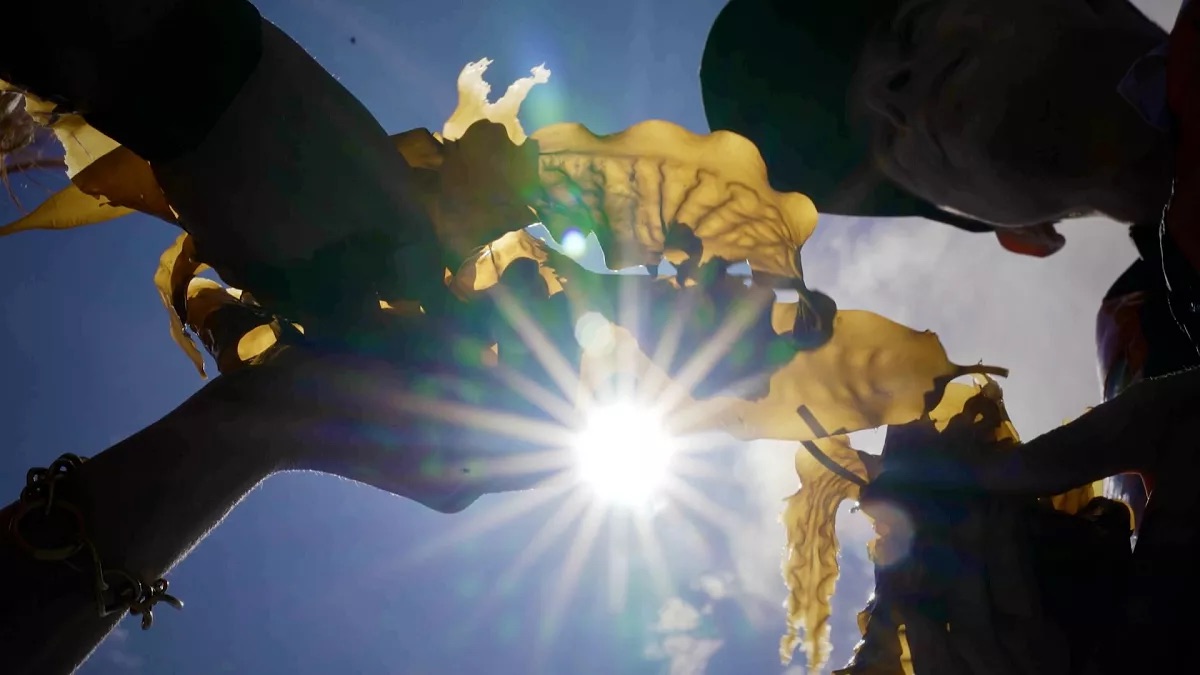In the northeast of Holland, 14 large antenna dishes have been placed next to each other in a 2.7 km long line.
Charles Yun, project manager: “We’re here at the Westerbork synthesis radio telescope, the Westerbork array, and these telescopes can be linked together to act as a single larger instrument”.
The antennas, or array, have become part of the global radio astronomy network. Using a technique, known as Very Long Baseline Interferometry – VLBI – scientists can collect and filter signals received from multiple radio telescopes.
Charles Yun, project manager: “The signals which are collected here are sent to the correlator, and those signals are mixed with telescopes located around the world to generate an extremely accurate image as if we were using a single dish that was the size of a combined radius of all the telescopes around the world. So using that process of e-VLBI we’re able to generate images that are several orders of magnitude more accurate or more clear than those obtained by even the Hubble space telescope”.
With traditional VLBI, data from each telescope is recorded onto tape or hard disk and sent to a central computer for filtering.
Radio images captured by an individual telescope can lack resolution, with relatively small celestial objects becoming impossible to discern.
This is where interferometry comes in: by pointing several telescopes towards an object similar data from different points can be collected. The recorded radio waves are then superimposed and amplified.
The further apart the antennas are from each other – the better quality of image produced.
The maths behind the project requires a supercomputer located 20 km from the Westerbork array at the Joint Institute for VLBI in Europe – JIVE for short. Until recently, all the telescopes participating in the experiment sent data on magnetic tapes or hard drives. This caused delays in the operations of the European network.
Huib Jan van Langevelde, JIVE director: “In the EVN, sometimes 11, sometimes 8, sometimes 16 telescopes work together, and sometimes we work with telescopes on other continents as well”.
To get rid of delays, telescopes throughout the world are now being linked with the JIVE correlator by fiber optic cable.
Huib Jan van Langevelde, JIVE director: “Nowadays we’re busy trying to connect all the telescopes together in real time. It used to take weeks before the data arrived here, and more weeks before the scientist who had the original idea for the experiment would have access to their data. With e-VLBI we’re connecting the telescopes in the real-time, and the astronomers can have access to the picture of his favorite source the next morning”.
Real-time connection removes the need to transport hard drives between telescopes and the supercomputer: Now, data is routed through the internet using modern fibre optic networks.
Arpad Szomoru, Head of Technical Operations and R&D: “Once we’ve started using these things, this recording units which are basically PCs, it became possible, of course, also to use the Internet – not just to use recording but to send the data directly, to stream it from the telescope directly to the correlator, and that’s what we’ve been doing the last few years”.
The electronic Very Long Baseline Interferometer acts as an instrument of global dimensions. Astronomers use it to get high-resolution images of distant objects, reacting instantly to any unexpected changes in space…
One telescope linked to the JIVE correlator is the 76 meter dish at Jodrell Bank Observatory near Manchester. The Lovell telescope, which marked its 50th anniversary last year, is the third largest steerable antenna in the world. Despite its age, it continues to play an important part in international science observations.
But, as the director for Jodrell Bank’s Centre for Astrophysics explains, even a real-time global network will be insufficient to fulfill the scientific requirements of the near future.
Phil Diamond, European Coordinator for project PrepSKA: “It [the European VLBI network] satisfies one need, which is that astronomers are able to get very detailed pictures of other galaxies, of regions around massive black holes, of regions of stars forming. But it doesn’t satisfy other requirements in any way at all. Because what need is massive sensitivity. We’re limited in the number of objects we can observe, and therefore we’re limited in our ability to understand the physics of how stars form, how black holes form. And so what we need are networks of telescopes hugely larger than those we have now. And this is one of the origins behind the development of the Square Kilometre Array”.
The Square Kilometre Array, partly funded by Europe, will be capable of surveying the entire visible sky. The plan is to build it by 2020 in a desert either in Southern Africa or Australia.
Richard Schilizzi, International SKA Project director: “The Square kilometre Array will have a 100 times larger collecting area than this gigantic dish sitting outside there. It is going to be the most powerful radio telescope on Earth – there will be only one of them, the radio astronomy community decided that right at the beginning, and it was a global project right from the start”.
“What you see in the animation is first close-up of the 15 meter dishes, which are spread in the central five kilometers, which is what you see when you drive up in the vehicle. And then you take an aerial view which shows you how it will look like from an airplane. And you see in the centre, which is central 1 km, much more dense concentration of dishes – there will be about 25% of total array in the center of that 1 kilometer. Right at the center you see a flat panel – flat round, circular panel which is made up of flat panels wich can look anywhere at the sky – it’s essentially a telescope with no moving parts. All the parts are connected up via electronics, very clever, it allows us to look possiibly into different directions simultaneously, as well as having a big area of reception on the sky. And then what you see as the final shot as you’re disappearing off into space you see the remote stations coming on in spiral arms”.
“It’s like the European VLBI network: the further away are these remote stations, the more details you can see because effectively you’re creating a telescope which is as large as the separation between those outermost regions, so you’re making a telescope – simulating a telescope which is three or four thousand kilometers across, so you get much greater detail”.
The Square Kilometre Array will continue the progress made by the European network towards a better understanding of the structure and evolution of our Universe.





